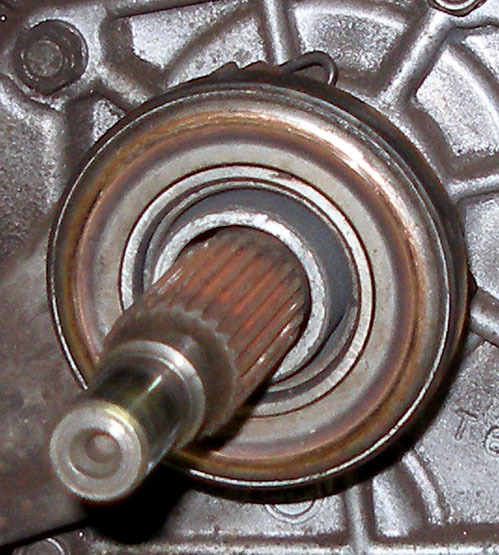Page 1 of 1
Clutch Troubleshooting / Repair
Posted: Wed Dec 27, 2006 5:46 pm
by the-486
Hey everyone, this is my first post to this forum!
The clutch in my 720 KC has suddenly became very limp. I am unable to get the tranny into gear. So my diagnosis is the Master/Slave Hydrualic system has failed.
What is the best way to dertermin where the system has failed?
Can I rebuilt the cylinders or should I buy new replacements?
Does anyone have a good lead on places to look for these parts?
And lastly, how do I go about reinstalling the rebuilt/new parts?
Thanks,
-k
Re: Clutch Troubleshooting / Repair
Posted: Wed Dec 27, 2006 6:48 pm
by philip
The quick answer is replace with NEW assemblies, starting with the slave cylinder. While you're under there, replace the flex hose feeding the slave cylinder. My guess is ... it's the original.
Master and slave are readily available.
Re: Clutch Troubleshooting / Repair
Posted: Wed Dec 27, 2006 11:09 pm
by the-486
thanks for the tips Philip!
philip wrote:My guess is ... it's the original.
Master and slave are readily available.
Yes, I think you are right, the clutch parts are OG factory.
The flexline that you are talking about, is that also readily available too?
Any advice about install of the new system and adjustment?
thanks!
best reguards
-k
Posted: Thu Dec 28, 2006 8:39 am
by moose60
486-
My experience with hydraulic clutch component replacement is that you just unbolt and swap parts. Take care not to kink any metal lines as you disconnect the. Penetrating oil and a touch of heat may help with the initial removal. Adjustment consists of bleeding the air from the lines and cylinders. Any automotive manual will have a good description of the bleeding procedure, wikipedia or google will also provide info.
Basically just keep pushing new fluid in with the pedal (while keeping the reservoir full!) as you (and/or your handy helper/neat bleeder gizmo from the autoparts store) allow the air and some fluid to escape at the bleed fitting on the slave cylinder. During the process you should not allow additional air into the system. This is accomplished by opening the bleeder only while there is some pressure in the line, and keeping the reservoir topped up.)
You also may want to check the clutch fork boot while you are in there. This is a piece of rubber that fits around the lever which is actuated by the slave cylinder. The boot keeps water and road dirt out of the bell housing. Mine's toast, and I bet many of the out of sight (out of mind) rubber parts have degraded on these trucks.
Good luck,
Posted: Thu Dec 28, 2006 10:09 am
by the-486
Thanks Byron!
Great info! I can't wait to get into this project this weekend.
Posted: Mon Jan 15, 2007 3:12 pm
by philip
Al: I've decided to pull (sublet) the trans to determine and repair a failure to disengage condition with the clutch. My estimate is the pilot bearing / bushing is seizing or the friction disc is binding on the input shaft splines. $:x$
Later ... Jan 24
Truck goes in today. Wonder which it will be.
update
Posted: Mon Jan 15, 2007 3:22 pm
by the-486
I got time to work on my clutch issues.
I got new slave & master cylinders from Napa, as well as two lenghts of flexible brake line and a coupler. I took out the crusty old slave / damper / master cylinders. I did not see much of a point to leave the damper in the system as it is just a complication to a simple as pie hydraulic setup, and it made the repair easier on me.
I installed the new master cylinder and primed it with my Mity Vac! (love this thing!) Installed the slave, ran the new brake lines, bled the system and I was back in business. Shifts nice and easy. But you have to travel the clutch pedal all the way to the floor to engage, disengage gears. But it's working, and I'm happy!
Now I just need to deal with the rough starting, massive smoke clouds, and intermittent pinging / knocking sounds. I got this truck with a full tank of fuel that sat for 5 years. I'm hoping it's just bad fuel. But I will save that for another post.
Thanks again for the help everybody!
This forum rocks!
Posted: Fri Jan 26, 2007 5:40 pm
by philip
Shop pulled the transmission today. Pilot bushing okay. Nothing unusual found but for ... a generous layer of hard, dry RUST on the input shaft and friction disc splines. DRY as a bone. So I'm lubing the splines and pilot bushing with BMW's "Staburags NBU 30 PTM" specialty paste for the purpose. New throw-out bearing for good measure.
Description
STABURAGS NBU 30 is a lubricating grease
based on mineral oil and a barium complex
soap.
STABURAGS NBU 30 has a high resistance to
mechano-dynamical loads and good wear
protection.
The grease also offers good corrosion
protection, water resistance as well as
resistance to many diluted alkaline and acid
solutions.
Here, Al found a fairly normal rust accumulation ... far less than what caused my clutch to hang.

Posted: Sun Jan 28, 2007 6:07 pm
by philip
Got the "come and git it" call. New friction disc, pressure plate, throw-out bearing, and pilot bushing. Bmw grease on the splines, bushing, and diaphragm spring contact area.
The clutch pedal pressure is noticeably lighter and there is noticeably less input shaft chatter in Neutral with clutch released. Hmmmm.
One of the exhaust flange studs twisted off so ... there was that additional repair.
